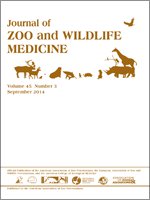Malignant melanomas are aggressive neoplasms that are relatively common in penguins compared to other avian species. In this study, the clinical and pathologic characteristics of melanocytic neoplasms in five macaroni (Eudyptes chrysolophus), three rock hopper (Eudyptes chrysocome), and two Humboldt (Spheniscus humboldti) penguins are described. Tumors most commonly occurred in the skin of the foot or hock, and were seen in the subcutaneous muscle, especially near the beak/oral cavity. Gross lesions were usually heavily pigmented, becoming raised and ulcerated over time. Humboldt penguins had a unique presentation, forming variably pigmented, cornified lesions in the inguinal area. Original case materials were obtained from all but two cases, and were assessed to define the characteristics of malignancy, evaluate four immunohistochemical markers for melanoma, and look for factors useful to informing prognosis and clinical decisions. Diagnosis was made histologically, based on morphologic features and pigmentation. Though not necessary for diagnosis, PNL-2 was found to be a useful immunohistochemical marker. HMB-45 showed unreliable positive labelling and S-100, Melan-A and Ki67 were not useful. Several factors were associated with prognosis, including gross surface dimension, mitotic index, depth of neoplastic cell invasion, and degree of surface ulceration. Metastatic spread occurred to the liver, lung, adrenal gland, brain, and bone; all lesions showed positive labelling to PNL-2. The average survival after diagnosis was 7 mo, though complete surgical excision of tumors less than 2.0 cm was curative in two cases and radiation therapy prolonged survival in one penguin. The underlying pathogenesis associated with the high prevalence of melanocytic neoplasms in captive penguins could not be identified. Three different molecular methods were performed to look for viral particles and results were negative. Advanced age is the most probable associated risk factor; ultraviolet light and chlorine exposure, viral induction, and genetic predisposition were ruled out or considered unlikely.
BioOne.org will be down briefly for maintenance on 17 December 2024 between 18:00-22:00 Pacific Time US. We apologize for any inconvenience.
How to translate text using browser tools
1 September 2014
MALIGNANT MELANOMA IN THE PENGUIN: CHARACTERIZATION OF THE CLINICAL, HISTOLOGIC, AND IMMUNOHISTOCHEMICAL FEATURES OF MALIGNANT MELANOMA IN 10 INDIVIDUALS FROM THREE SPECIES OF PENGUIN
Ann E. Duncan,
Rebecca Smedley,
Simon Anthony,
Michael M. Garner
ACCESS THE FULL ARTICLE
immunohistochemistry
malignant
melanoma
penguin





